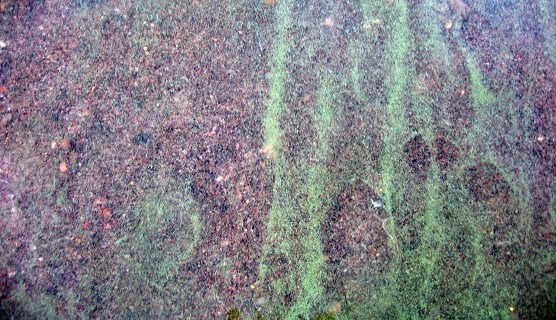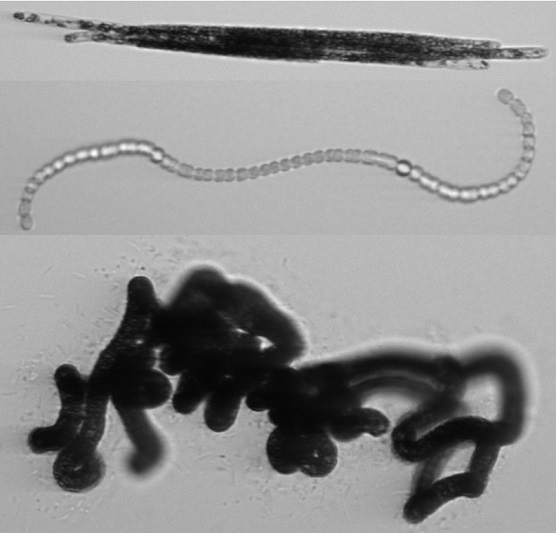Press release 2020-07-02 at 12:53

Blue-green algae. (Photo from archive). © Pirjo Ferin/SYKE
Less cyanobacteria have been observed at national algae monitoring sites as compared to last week. Windy and cloudy weather has restrained the occurrence of cyanobacteria both in the Finnish sea areas and in lakes. However, surface blooms of cyanobacteria may again become more abundant once the weather warms and winds calm down. Consequently, future weather conditions will determine the algal situation for the rest of the summer.
Read more in Finnish
Report your algal bloom observations to the Järvi-meriwiki (Lake and sea wiki)
In the Järvi-meriwiki maintained by the Finnish Environment Institute, everyone has the opportunity to establish their own observation site and share algal bloom observations from lakes and coastal areas. Individual observations can also be sent while navigating different water bodies. You can also report observations using the smartphone-friendly Havaintolähetti website. The reported observations are shown on the national algal situation map, and they support the national algal situation assessment. Observations about the absence of cyanobacteria are also important.
Järvi-meriwiki is an online service produced in collaboration with authorities and citizens. The service provides basic information on all lakes larger than one hectare as well as different areas of the Baltic Sea. Users can share, for example, photos and other observations on the service.
Municipalities and cities monitor the cyanobacterial situation on the beaches, so it is advisable to report rich cyanobacterial blooms on beaches to the health authorities of the municipality in question.
Cyanobacteria observations also in the Itämeri.fi service
This summer, a website on algal bloom observations on the Itämeri.fi service is also launched. The cyanobacterial map presented on this algal bloom observations page combines the observations reported to the Järvi-meriwiki and from the beaches of the City of Helsinki as well as the observations based on satellite interpretations of the Finnish Environment Institute during the last three days.

The most common bloom forming Baltic Sea cyanobacteria (from top; Aphanizomenon flosaquae, Dolichospermum sp., Nodularia spumigena), captured with Imaging FlowCytobot, from the shores of Utö island. Imaging FlowCytobot is an independently and continuously operating instrument that images microscopic algae, representing the new development of algae bloom monitoring and research. The changes in the algae community can be monitored with twenty minute intervals, which is impossible with the traditional methods. The instrument is being used for example in a research of possible climate change related shifts in the algae community of the Baltic Sea.
This is how you identify cyanobacteria
A small amount of cyanobacteria in the water appears as green or yellowish particles. Narrow stripes of algae can drift to a beach. In calm weather, a substantial amount of cyanobacteria forms greenish or yellowish algal rafts and piles up in coastal water. Unlike cyanobacteria, pollen is found not only on the surface water but also, for example, on piers or yard furniture.
If the algae dissolve into tiny particles in the water when you touch it with a stick, it may be cyanobacteria. If the algae attache to the stick, it is something other than cyanobacteria. In a glass of water, cyanobacteria rise to the surface as tiny greenish particles within about an hour.
Algae bloom risk analysis
The risk of cyanobacterial blooms in the Finnish sea areas is considerable or moderate – the summer weather determines the actual situation (Press release June 4, 2020)
Information about algae situation
Pictures
Give your opinion on improving the status of waterways!
More information
(Telephone 1.00-3.00 pm)
Lakes
- Researcher Laura Härkönen, Finnish Environment Institute SYKE, Tel. +358 295 251 009, firstname.lastname@ymparisto.fi (until July 3)
- University Intern Jere Laine, Suomen ympäristökeskus SYKE, Tel. +358 295 252 205, firstname.lastname@ymparisto.fi (from July 6)
Sea areas
Cyanobacterial bloom situation
- Researcher Kaisa Kraft, Finnish Environment Institute SYKE, Tel. +358 295 251 970, firstname.lastname@ymparisto.fi
State of the Baltic Sea
- Senior Research Scientist Mika Raateoja, Finnish Environment Institute SYKE, Tel +358 295 251 536, firtsname.lastname@ymparisto.fi
Communications
- Communications Intern Iris Aarola, Finnish Environment Institute SYKE, Tel +358 295 252 189, firstname.lastname@ymparisto.fi